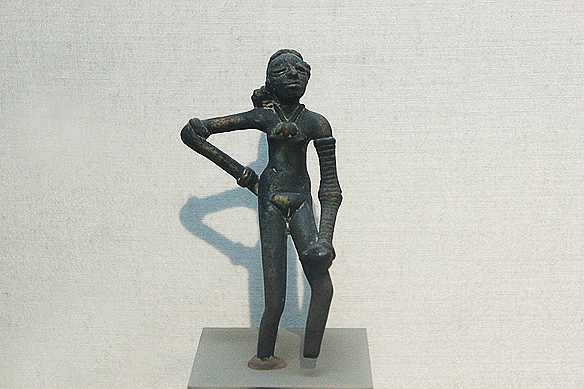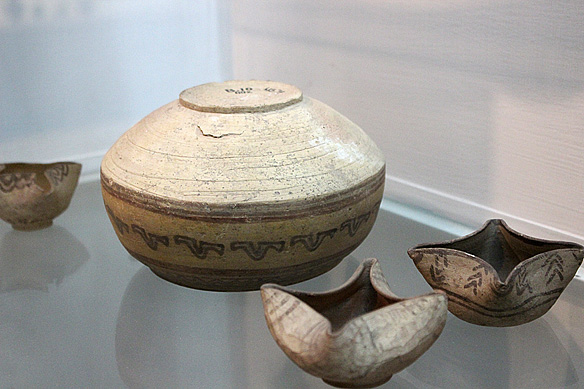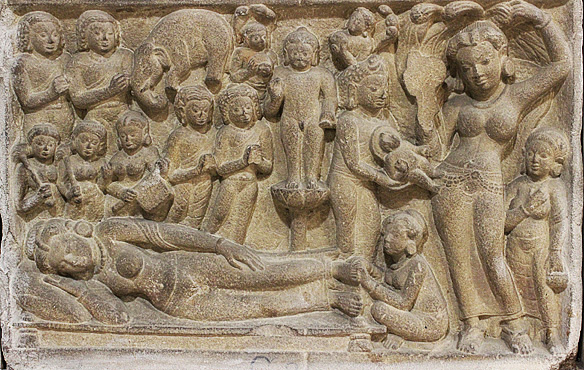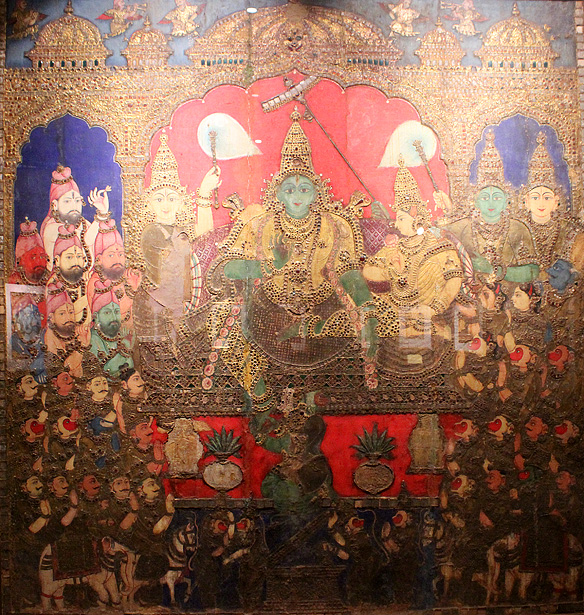
The National Museum, New Delhi makes the herculean task of experiencing India’s monumental heritage spanning 5,000 years—doable. You could always spend 3 minutes looking at each object in its 210,000 piece collection. But that would take 14.5 months with no sleep or meals inbetween. Or you could do an audio tour and spend a day exploring its glorious galleries through 64 masterpieces. And if you have just one and a half hours, then why not feast your eyes on its very best.
Earlier housed in the Rashtrapati Bhawan [President’s residence], the collection has its roots in 1947 when the Royal Academy, together with the governments of India and Britain, decided to hold an “Exhibition of Indian Art” in London. Selected artefacts from museums across India were collected for the showing.
Before returning the exhibits to their respective museums, it was decided to display the exhibition in Delhi as well. What a huge success it turned out to be! The overwhelming response led to the idea of a permanent National Museum being set up in the capital with its very own building by India Gate which it moved into in 1960.
The National Museum has it all. From the iconic Harappan Dancing Girl to elegant Gandharan Buddhas, from exquisite miniature Mughal paintings to luscious Tanjore compositions, from Chola bronzes to 20th Century decorative arts, from medieval sculptures of voluptuous Hindu deities to diamond and emerald regalia of its once-upon-a-time royalty. The Museum has all these, and much much more.
Here are my 15 favourite pieces collated after rambling through its collections and meditating over its audio tour. Doable in 90 minutes. 🙂
Tell me, what’s your favourite(s)?

Dancing girl [2700 – 2000 BC, Mohenjo-Daro, Bronze]. Sophisticated and elegant, this 10.5 cm-high free-standing millennia-old bronze figurine is one of the world’s earliest examples of metal casting using the lost wax method. Engrossed in her dance, she was discovered in 1926 in Mohenjo-Daro, present day Pakistan. Mohenjo-Daro jewellery and attire still prevail in western India. [Harappan Gallery; audio tour stop no. 3]

Nal pottery [3000 BC, Early-Harappan]. Found in north-west India, Nal pottery is characterised by polychromatic colouring and geometric patterns using fine lines, shapes, and concentric circles. It was made on potters’ wheels and fired at high temperatures. I love the little bowls. Absolute epitomes in minimalist design. [Harappan Gallery; audio tour stop no. 6]

Buddha [2nd Century AD, Gandhara, Schist]. The Kushana period [1st to 3rd Century AD] was a visually profuse one with Buddha being represented in human form for the first time. Two main artistic centres emerged under the Kushanas: Mathura and Gandhara. The latter by virtue of having been the eastern border of Alexander’s empire is lush with Greco-Roman iconography, form, and costumes. Interesting factoid: The official language of the Kushana period was Greek. 🙂 [Mauryan Gallery; audio tour stop no. 9]

Parvati head [4th – 6th Century AD, Uttar Pradesh, Terracotta]. Parvati was Shiva’s consort and an embodiment of love, devotion, and fertility. The sculpture is representative of the Gupta period, a golden era for Indian art in which human, flora and fauna forms reached classic perfection and set the standard for artistic creation in the following centuries. Note her carefully coiffured hair and hooped earring. Pretty woman! [Gupta Art Gallery; audio tour stop no. 11]

Yogini Vrishanana [10th – 11th Century, Uttar Pradesh, Stone]. The yogini is deep in meditation, seated in lalitasana, her animal head symbolic of yoga’s intuitive, instinctive nature. Simple circular roofless structures, Yogini temples are usually built in remote, isolated places. [Early Medieval Indian Sculpture Gallery; audio tour stop no. 15]

Surya [13th Century, Konark, Odisha, Stone]. A prized exhibit of the National Museum, the towering sculpture stands in the foyer and is marked with perfect sculptural rhythm and clearly defined features. [Late Medieval Indian Sculpture Gallery; audio tour stop no. 18]

Bharata with Rama’s sandals [14th Century, Vijayanagar, Bronze]. In the Ramayana, when Rama refused to return to the kingdom of Ayodhya, Bharata took his sandals and placed them on the throne to rule as regent of the kingdom. In this classic sculpture, Bharata raises his arms to support the sandals placed on his head.
Post title image: Nataraja [12th Century, Chola, Tamil Nadu, Bronze]. This is my absolute favourite piece in the entire museum. Nataraja, the Lord of Dance is regarded as the most outstanding expression of divine rhythm and harmony in Indian art. It signifies the cosmos and hence the omnipresence of Shiva. The bronze does more than justice to this belief. [Bronzes Gallery; audio tour stops no. 19 and 20]

Scenes from Buddha’s life [5th Century, Sarnath, Uttar Pradesh, Stone]. The above panel depicting the birth of Buddha is the bottom-most in a series meant to be read from left to right, bottom to top. According to legend Buddha’s mother dreamt of a white elephant; this was followed with his birth from the side of her hip.
Just across the room and the focal point of the gallery is Buddha’s relics displayed in a shrine made by Thai artisans. Thousands of pilgrims come to the museum to pay their homage to it. The relics were discovered at Kapilavastu, Buddha Sakyamuni’s home-town. [Buddhist Art Gallery; audio tour stops no. 21 and 22]

There are nearly 17,000 miniature paintings covering all the main schools at the National Museum. These comprise: Deccani [from the south], Mughal [spanning central and north India], Rajasthani [west India] and Pahari [from the hills of the north].
Top: Mughal Emperor Jahangir (1605 – 27) holding the picture of Madonna [1620, Mughal School]. Quite an eclectic composition, wouldn’t you agree? Sir Thomas Roe came to Jahangir’s court in 1615 as an ambassador of King James I. He carried with him several paintings on Christian themes which led to the introduction of European elements in Mughal miniatures. Bottom: Detail, Radha and Krishna admiring each other in a mirror [1640, Mewar, Rajasthani School]. Most Rajput art focused on religious themes such as the Ramayana and Mahabharata, and Krishna’s life. [Paintings Gallery; audio tour stops no. 24 and 26]


Left: Tusk depicting Buddha’s life scenes; Right: Detail, Buddha in dhyana mudra [meditation] [Early-20th Century, Delhi, Ivory]. This piece, for me, was a validation of the timelessness of India’s rich heritage. Ancient motifs and styles recreated by today’s artists. The tusk is covered with 43 scenes and ends with Buddha’s mahaparinirvana [final nirvana after death]. [Decorative Arts Gallery I; audio tour stop no. 30]

Turban ornament [sarpech] [19th Century, Rajasthan, Gold, Diamonds, Emeralds]. Yup, those are real diamonds and emeralds. For more than 2,000 years India was the sole supplier of gemstones to the world, earning the nickname “Golden Bird” or Sone ki Chidiya. Golconda diamonds were coveted internationally whilst precious stones poured into the gem bazaars scattered across the length and breadth of the country. This piece would have decorated a maharaja’s turban. [Jewellery Gallery; audio tour stop no. 35]

Rama darbar: The coronation of Rama at Ayodhya [1825 – 50, Tamil Nadu, Cloth pasted on wood]. This large size painting [270 X 249 cm with frame] is a masterpiece in the Maratha period Tanjore style and was earlier in the royal family of Tanjore’s private collection. Rama and Sita are shown seated on the throne after his coronation ceremony, accompanied by Lakshmana, Bharata, Shatrughana, Hanuman, and various nobles and sages. Even with the paint and gold now flaked off in parts, it is still magnificent.
Tanjore paintings have a brilliant jewel-like appearance which is achieved by using real gold and silver foil, precious and semi-precious stones, beads, mirrors, and powdered metals together with primary colours, to depict the gods. [Tanjore and Mysore Gallery; audio tour stop no. 38]

Mehrabi coin of Akbar [1556 – 1605, Gold]. Mughal coinage ranks amongst the greatest currencies of the world and is embellished with zodiac signs, portraits, and literary verses in flawless calligraphy. The Mehrabi are hexagonal commemorative gold coins issued by the Mughal Emperor Akbar. Abu’l-Fath Jalal-ud-din Muhammad, popularly known as Akbar I and later Akbar the Great, was the third Mughal emperor. [Coins Gallery; audio tour stop no. 44]

Book cover with Buddha in preaching, protection, and earth touching posture [17th Century, Tibet, Carved and Painted Wood]. Tucked inside a deserted gallery on the second floor are 82 of India’s finest wood carvings, both ritualistic and secular, from the 17th to 19th Centuries. Filled with lintels, statuettes, and household objects, such as this book cover which once held together an ancient Buddhist manuscript, it is enough to make you gasp in wonder before you leave the museum, your 90 minutes completed. [Wood Carving Gallery; audio tour stop no. 60]
Travel tips:
- Address: National Museum, Janpath, New Delhi – 110011.
- Timing: 10:00 am – 6:00 pm [Closed on Mondays and Public Holidays].
- Ticket: Rs. 20 for Indians; Rs. 650 for foreigners.
- Audio guide: Rs. 150 for Indians; Included in ticket price for foreigners.
- Free guided tours are available daily at 10:30 am and 2:30 pm.
- Still photography is allowed inside.
- Cloakrooms are available at no charge.

excellent
LikeLiked by 1 person
Thank you, Arjun. Glad you enjoyed it. 🙂
LikeLiked by 2 people
It’s really amazing to experience these things in front of you especially for someone like me who’s a History lover.
I have read plenty of Books on Ancient Indian civilizations like Hadappa,Jorwe,Malwa,Dravid Civilizations.
I have visited the Museum at Mysore and couldn’t explain the feeling
LikeLiked by 1 person
Nice to meet another history buff. 🙂 Yup, museums do have that effect. I must visit the Mysore museum some day. Have heard a lot of wonderful things about it.
LikeLiked by 1 person
Yupp. It has the largest pre-historical stuff
LikeLiked by 1 person
I have been to that museum twice and its worth visiting for. Large collection, there is something similar at Mumai too. Great post!
LikeLiked by 1 person
Thank you, Raj. 🙂 Yes, the CSMVS aka Prince of Wales Museum in Mumbai is pretty fantastic too. I love its sculpture gallery and in fact wrote a whole post on it some time ago. In case you’d like to read it, the link is: https://ramaarya.wordpress.com/2015/05/20/csmvs-sculpture-gallery/
LikeLiked by 1 person
Thanks for the link.. I will check that out.. CSMVS.. I liked the armors section .. Akbar’s armor and swards … I get goosebumps even to think about it. 😀
LikeLiked by 1 person
Thanks for the tip. Will go and check out the armoury section for sure. You’ve inspired me to do a global travel shot on Akbar’s armour 🙂
LikeLiked by 1 person
I’ve been to this museum and hope to visit again – the number of exhibits is impossible to cover in one go. I was really impressed by the jewelry and precious stones gallery – in everyday life I’m completely indifferent to jewelry, and I wouldn’t say the workmanship of the exhibits were as great as to be considered outstanding works of art. But there was something real about them – they were actually “speaking” of the era gone by. Thanks for the interesting post!
LikeLiked by 1 person
Hello, Antonina. I like the phrase — the jewels “speaking” of the era gone by. I guess they do. One can almost catch wisps of the people who once wore these pieces. I was just amazed at the size of the stones. They were more like rocks. 😀
LikeLike
excellent
LikeLiked by 1 person
Am happy you enjoyed the post. 🙂
LikeLiked by 1 person
Interesting !
LikeLiked by 1 person
And this is just the tip of the iceberg. There is so much more to explore and learn at the National Museum. 🙂
LikeLiked by 1 person
Pingback: national museum, new delhi – 90 minutes at the museum | aadildesai
My favourite museum in New Delhi. Always find something new to see there!!!
LikeLiked by 1 person
Am rather ashamed, to say the least, that I just discovered it recently. But now that I have, I hope to explore it at length, a gallery at a time. 🙂
LikeLike
Lovely
LikeLiked by 1 person
Pingback: delhi’s national museum bronze gallery: where bronzes sing tales of god and art | rama arya's blog
Pingback: national crafts museum, new delhi – 90 minutes at the museum | rama toshi arya's blog